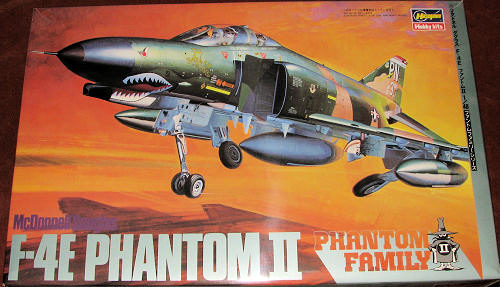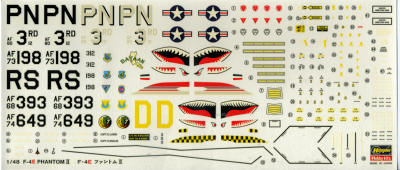Hasegawa 1/48 F-4E Phantom II
| KIT #: | P3 |
| PRICE: | $17.95 on the sticker, but new it is not |
| DECALS: | Four options |
| REVIEWER: | Scott Van Aken |
| NOTES: | Initial F-4E boxing (1984) |

One of the early lessons of the conflict in Vietnam was that modern jet fighters really needed an internal gun. Pod mounted guns were thought to be the best way to deal with that, but the truth was that these weapons were never able to be as rigidly mounted as one in an airframe. Besides, there was no way to really sight one of these. So early in the war, it was decided by the USAF to arm its future Phantoms with guns. While they were at it, they also upgraded the avionics and the engines. A bit later, they improved the airframe as well by adding slatted wings. This latter upgrade allowed a 10% improvement in turning radius at the expense of some speed. This was retrofitted to most all extant F-4E airframes. So equipped, this is how the Phantom operated for the rest of its life in USAF/ANG service. The initial F-4Es were 1966 fiscal year builds and entered combat around 1968. More F-4Es were built than any other variant. Most extant 1969 fiscal year F-4Es were rebuilt to F-4G Wild Weasel configuration in the 1980s.
 According to the date on the instructions, this kit was initially released in 1984 and that seems about right. The kit actually retailed for $19.95, but as it is today, it was not difficult to find it discounted. Even so, it was a lot of money in those days. Unlike their earlier F-4B/N and C/D releases, this one had two of the four main sprues with engraved detailing. The other two, which includes the drop tanks, were from the earlier F-4C/D kit and so had raised detail.
According to the date on the instructions, this kit was initially released in 1984 and that seems about right. The kit actually retailed for $19.95, but as it is today, it was not difficult to find it discounted. Even so, it was a lot of money in those days. Unlike their earlier F-4B/N and C/D releases, this one had two of the four main sprues with engraved detailing. The other two, which includes the drop tanks, were from the earlier F-4C/D kit and so had raised detail.
The fuselage has a separate nose and this nose only has the later, elongated gun muzzle. The nose is on a smaller separate sprue. The wings are the later slatted version with the fairings already molded into the bottom of the lower wing so any back-dating using the kit wings would require some work. Fortunately, Hasegawa released an early F-4E and you can find this in an older Pro-Modeler boxing as well. So this basically means you have to model an airframe from around the 1974/75 and later time frame. I should also mention that when joining the wings, there will be a seam through the lower flaps that will need to be filled.
The cockpit is very nice for the time with raised detail on the instrument panels and side consoles. The bang seats are good representations of the MB Mk 4 used by the F-4 but are devoid of straps and other fine detailing. This is because the kit comes with a full crew and you are supposed to install these folks inside. The cockpit is a relatively accurate USAF F-4 cockpit with control sticks for both crew members.
The kit comes with the correct longer burner cans for the updated J79-GE-17 engines. It also comes with the slatted stabs that have the reinforcement arrow. Landing gear are well done and though there is little detail in the wheel bays, is typical of the time. So is the typical ejector pin marks on the gear, inside of gear doors, on weapons, and so on. The kit includes a weapons suite that includes both Sidewinders and Sparrows. The drop tanks are typical of the era so that means no F-15 style centerline. This will further limit the time period as around the mid 1980s, this was pretty well universal on the F-4E.
The kit provides markings for four aircraft from two units. All of the options are in the standard SEA camouflage, which puts the  aircraft in service around the late 1970s or so. Two options are from the 3 TFW based at Clark AFB in the Philippines. One is the box art wing commander's plane with white tail codes from 1981. You can also do this plane with the black tail codes as it was in 1982. The other is a standard line bird from the 3 TFS in 1982 with black tail code. The other two are from Ramstein AFB in Germany. The first is a 512 FTS/86 TFW plane as it was during the Tactical Air Meet in 1980. This one has a shark mouth. The other is a standard line bird from the 526 TFS in 1978. This latter plane has the SEA wrap scheme without the light grey underside. The instructions give a full camo scheme for this and the other options. The decal sheet is large and well printed. Despite being nearly 30 years old, the sheet still looks viable, but most will opt for aftermarket on a kit that has been around this long.
aircraft in service around the late 1970s or so. Two options are from the 3 TFW based at Clark AFB in the Philippines. One is the box art wing commander's plane with white tail codes from 1981. You can also do this plane with the black tail codes as it was in 1982. The other is a standard line bird from the 3 TFS in 1982 with black tail code. The other two are from Ramstein AFB in Germany. The first is a 512 FTS/86 TFW plane as it was during the Tactical Air Meet in 1980. This one has a shark mouth. The other is a standard line bird from the 526 TFS in 1978. This latter plane has the SEA wrap scheme without the light grey underside. The instructions give a full camo scheme for this and the other options. The decal sheet is large and well printed. Despite being nearly 30 years old, the sheet still looks viable, but most will opt for aftermarket on a kit that has been around this long.
Even after all these years, this is still a highly sought kit and one that has yet to be eclipsed. Those of us who have built 1/48 Hasegawa Phantoms will pretty well know what to look for in terms of where it will have areas that need work (such as intakes and the fuselage aft of the wings) so will be able to quickly overcome those obstacles. It builds into a rather impressive kit and is one that no F-4 fan should be without.
http://en.wikipedia.org
August 2012
If you would like your product reviewed fairly and fairly quickly, please contact the editor or see other details in the Note toContributors.
Back to the Main Page
Back to the Previews Index Page


 According to the date on the instructions, this kit was initially released in 1984 and that seems about right. The kit actually retailed for $19.95, but as it is today, it was not difficult to find it discounted. Even so, it was a lot of money in those days. Unlike their earlier F-4B/N and C/D releases, this one had two of the four main sprues with engraved detailing. The other two, which includes the drop tanks, were from the earlier F-4C/D kit and so had raised detail.
According to the date on the instructions, this kit was initially released in 1984 and that seems about right. The kit actually retailed for $19.95, but as it is today, it was not difficult to find it discounted. Even so, it was a lot of money in those days. Unlike their earlier F-4B/N and C/D releases, this one had two of the four main sprues with engraved detailing. The other two, which includes the drop tanks, were from the earlier F-4C/D kit and so had raised detail.  aircraft in service around the late 1970s or so. Two options are from the 3 TFW based at Clark AFB in the Philippines. One is the box art wing commander's plane with white tail codes from 1981. You can also do this plane with the black tail codes as it was in 1982. The other is a standard line bird from the 3 TFS in 1982 with black tail code. The other two are from Ramstein AFB in Germany. The first is a 512 FTS/86 TFW plane as it was during the Tactical Air Meet in 1980. This one has a shark mouth. The other is a standard line bird from the 526 TFS in 1978. This latter plane has the SEA wrap scheme without the light grey underside. The instructions give a full camo scheme for this and the other options. The decal sheet is large and well printed. Despite being nearly 30 years old, the sheet still looks viable, but most will opt for aftermarket on a kit that has been around this long.
aircraft in service around the late 1970s or so. Two options are from the 3 TFW based at Clark AFB in the Philippines. One is the box art wing commander's plane with white tail codes from 1981. You can also do this plane with the black tail codes as it was in 1982. The other is a standard line bird from the 3 TFS in 1982 with black tail code. The other two are from Ramstein AFB in Germany. The first is a 512 FTS/86 TFW plane as it was during the Tactical Air Meet in 1980. This one has a shark mouth. The other is a standard line bird from the 526 TFS in 1978. This latter plane has the SEA wrap scheme without the light grey underside. The instructions give a full camo scheme for this and the other options. The decal sheet is large and well printed. Despite being nearly 30 years old, the sheet still looks viable, but most will opt for aftermarket on a kit that has been around this long.